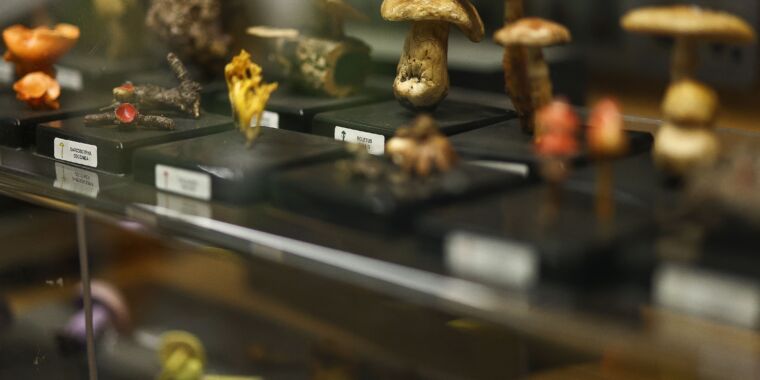The Hidden World Beneath Kew Gardens
When strolling through Kew Gardens in London, it’s easy to be captivated by the towering redwoods and giant Amazonian water lilies. However, the real treasures of Kew lie beneath the surface. Tucked away beneath a laboratory at the garden’s eastern edge is the fungarium, home to the largest collection of fungi in the world.
Nestled inside green cardboard boxes are approximately 1.3 million specimens of fruiting bodies, the parts of fungi that emerge above ground. Lee Davies, the curator of the Kew fungarium, describes it as a “library of fungi” that provides a comprehensive reference of fungal biodiversity worldwide.
Digitizing the Fungarium
Archivists, adorned with mushroom hats for some reason, tirelessly work to digitize the vast archive. This digitization effort aims to document around half of all fungal species known to science. Davies explains, “What this allows us to do is to come up with a reference of fungal biodiversity—what fungi are out there in the world, where you can find them.”
In the past, fungi were often overlooked in the environmental realm. However, Davies himself experienced a transformation in perspective after being assigned to the fungarium in 2014. Originally working with tropical plants, he now regards the fungarium as “the best thing ever” and expresses his love for it.
The Fungi Awakening
Davies’ newfound appreciation for fungi mirrors a broader awakening to the importance of these organisms. In 2020, mycologist Merlin Sheldrake’s book “Entangled Life” became a surprise bestseller, shedding light on how fungi impact our world. Even popular culture, like the video game and HBO series “The Last of Us,” features a fictional brain-eating fungus, highlighting the intrigue surrounding these organisms.
At Kew Gardens, the collection includes a tarantula infected with Cordyceps, a fungus that sends the world into an apocalyptic spiral in “The Last of Us.” Fungal tendrils extend from the gaps between the deceased insect’s limbs, showcasing the eerie yet fascinating nature of fungi.
Fungi’s Environmental Role
While public interest in fungi grows, scientists are delving into the vital roles they play within ecosystems. Just above the Kew fungarium, mycologist Laura Martinez-Suz investigates how fungi contribute to carbon sequestration in soil. Understanding why certain locations are more effective at storing soil carbon than others is a key focus of her research.
Soil serves as a massive carbon reservoir, with approximately 1.5 trillion tons of organic carbon stored worldwide—twice the amount in the atmosphere. Previously, it was believed that most soil carbon resulted from decomposing plant matter. However, studies, such as one in forested islands in Sweden, reveal that root-fungi networks are crucial in carbon storage, surpassing the contribution of fallen plant material.
Image/Photo credit: source url





